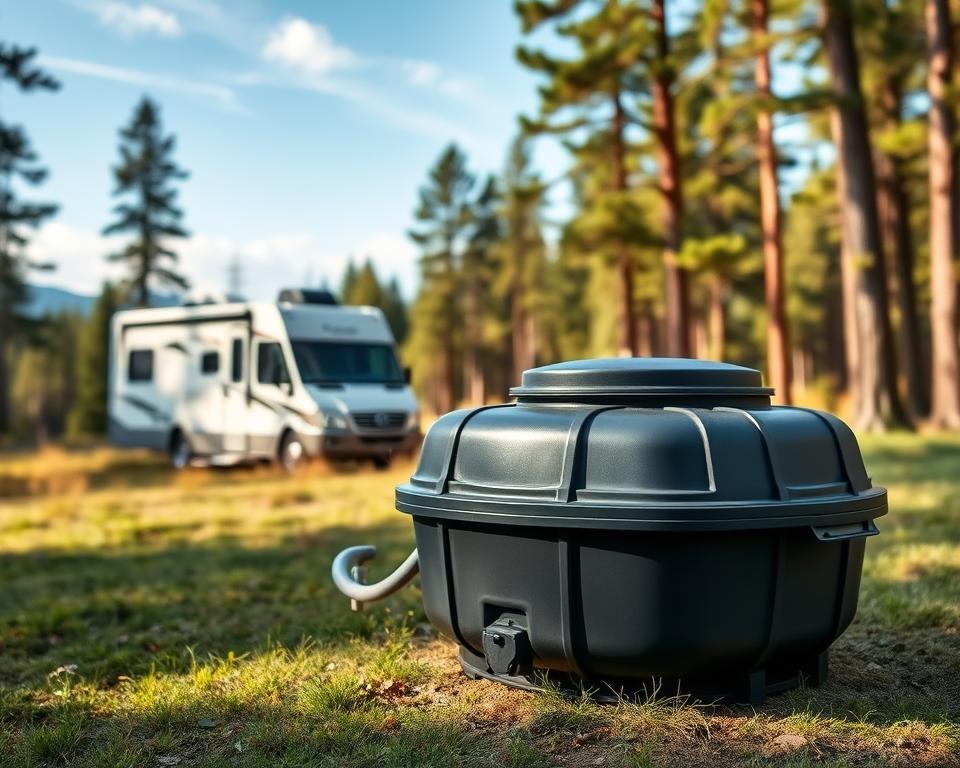Enhance Your RV’s Water Setup Using a Pressure Tank
Have you thought about the impact of an RV pressure tank on your camping journeys? During your travels, your RV’s plumbing system becomes vital for daily activities like bathing and dishwashing. Optimizing this system ensures a steady and reliable water flow, essential while traveling. Let’s explore how an RV pressure tank can boost your onboard water system – RV septic removal, uplifting comfort during your adventures.
Core Lessons
- An RV pressure tank enhances water flow as you travel.
- Reliable water systems are crucial for everyday RV tasks.
- Fine-tuning plumbing enhances your outdoor stay.
- Pressure vessels ensure even delivery.
- Enhanced delivery benefits every fixture.
Why a Dependable RV Water System Matters
Consistent plumbing is key to enjoyable RV trips. It ensures daily tasks like showering, washing dishes, and using the toilet are smooth. Issues like low water pressure can hinder these activities, highlighting the necessity of proper water flow in your RV.
Low water pressure can stem from several issues. Leaks, clogged filters, or insufficient water supply are common causes. Not only do these problems disrupt convenience, but they can also lead to bigger problems without timely intervention. Thus, regular upkeep is essential for a well-functioning RV plumbing system.
Important aspects of maintaining a robust RV water system include:
- Regularly checking for leaks in pipes and connections
- Cleaning or replacing clogged filters when necessary
- Employing a water pressure regulator to safeguard against surges
Keeping these practices top of mind empowers RV owners to enhance their water flow. It makes the camping experience enjoyable.

What is an RV Pressure Tank?
A pressure tank is essential to your camper’s plumbing. It ensures water pressure remains stable and consistent. This component holds and balances water, making it available even when demand peaks. It avoids the inconvenience caused by pressure fluctuations.
The design of an RV water pressure tank often incorporates a bladder or diaphragm. This mechanism separates water from air, allowing for swift pressurization. Understanding how a camper pressure tank works empowers RV owners to take control of their water system. A quality motorhome pressure tank boosts water delivery’s reliability and efficiency.
The Way a Pressure Tank Improves Water Delivery
The pressure tank ensures steady delivery. It avoids flow drop-outs under simultaneous use. When faucets, showers, and toilets operate together, a pressure tank keeps the supply steady.
This tank takes the load off the pump system, leading to better energy use. It stores pressurized air, pushing water through the system. This results in the water pump activates less frequently. The result? Lower power draw and an extended water pump life.
Thanks to these tanks, RV owners enjoy dependable water flow, enhancing their experience. Consistent showers and efficient dishwashing become the norm. Knowing how a pressure tank works empowers users to avoid the hassle of varying water pressure.
| Characteristic | Benefit |
|---|---|
| Uniform Flow | Enhances overall water flow, improving usability |
| Less Pump Cycling | Decreases wear on your pump |
| Quick Water Delivery | Speeds up usage at any tap |
| Simple Setup | Simplifies upgrades to the RV water system |
Benefits of Installing a Recreational Vehicle Pressure Tank
Installing a pressure tank in your RV brings notable advantages. It leads to steady delivery, improving everyday chores. The absence of sudden water flow drops allows for fluid operation.
Another key benefit is the relief it offers your water pump. By maintaining even pressure, the tank extends the pump’s lifespan and cuts down on repair needs. This results in noticeable maintenance cost savings and less inconvenience over time.
Better water usage is another benefit. It helps avoid common pressure-related problems like leaks. These tanks boost plumbing system reliability, ensuring hassle-free trips. With proper setup and maintenance, they bring confidence and peace of mind.
Choosing the Right RV Pressure Tank for Your Needs
Choosing the correct RV pressure tank requires thought on many aspects to match your RV water system’s needs. Start by evaluating size. RV pressure tanks vary in size; knowing how much water you use will help pick the right one.
Material choice affects lifespan. Tanks constructed from stainless steel or polyethylene offer superior toughness. It’s crucial to select a tank that handles road vibrations and varying climates.
Diaphragm tanks stand out when considering options. They smooth out surges and protect pipes. Checking model specifications ensures compatibility with your system.
Getting advice from RV experts is beneficial. They ensure the tank works well with your RV’s plumbing, so you get a setup that runs flawlessly.
How to Fit the Pressure Tank
Installing a pressure tank in your camper is a crucial step toward enhancing your RV’s water system efficiency. It’s important to be thorough and follow plumbing best practices. Start by picking the right spot for future maintenance.
Next, fasten the supply and return lines tightly. Ensure all joints are sealed. A key part is verifying the air pressure inside the bladder, which is essential for optimal performance.
When unsure, hire a qualified technician, like those at All in Sanitation. Their expertise guarantees proper fitting, boosting your system’s flow and reliability. Always adhere to manufacturer guidelines for best results and durability.
| Installation Steps | Notes |
|---|---|
| Choose Position | Pick a convenient spot with easy access |
| Attach Lines | Secure inlet and outlet to avoid leaks |
| Verify Precharge | Use a pressure gauge |
| Follow Recommendations | Stick to install instructions exactly |
| Consult Experts | Ensure proper setup |
Pressure Tank Maintenance Tips
Extending your RV pressure tank’s life requires proper upkeep. Regular checks for leaks are essential to prevent water waste and ensure air pressure settings are correct. Additionally, check and clean filters regularly.
Cleaning the filter is vital to avoid blockages and maintain smooth flow. An annual inspection is recommended to assess the tank’s performance and the associated plumbing. Documenting maintenance makes tracking easier.
By keeping your system in top shape, you ensure a consistent water supply, contributing to comfort and convenience on your journeys.
| Maintenance Task | How Often | Description |
|---|---|---|
| Check for Leaks | Monthly | Look for drips or moisture |
| Air Pressure Check | Every Month | Use a gauge |
| Filter Maintenance | Quarterly | Keep pathways clear |
| Yearly Service | Annually | Assess tank and plumbing health |
Extra Tips to Boost RV Pressure
Implementing strategic practices can significantly improve RV water pressure. A water pressure regulator is vital, as it maintains steady flow and prevents damage from pressure spikes.
Avoid running multiple outlets at once. Stagger usage, for example, don’t run shower and dishwasher together.
Shortening shower times is key for maintaining strong pressure. This reduces demand on the system, improving overall performance.
A clean filter is essential. Don’t let debris choke your system. Regular maintenance ensures optimal performance.
Inspect the bypass valve often. A working bypass enhances performance, boosting the camper’s water system.
| Tip | What to Do | Impact on Water Pressure |
|---|---|---|
| Pressure Limiter | Prevent spikes | Keeps stress off fixtures |
| Stagger Usage | Prioritize one at a time | Reduces system overload |
| Quick Rinses | Reduce time spent in the shower | Conserves water, maintains flow |
| Filter Flushing | Ensure the filter is free from debris | Maximizes water flow |
| Check Bypass Valve | Test the bypass valve | Enhances overall efficiency |
In Closing
Recognizing the significance of the RV pressure tank is vital for enhancing your RV water system. It ensures a constant water flow and adequate pressure, improving your road experiences. This dependability turns camping into comfortable, enjoyable adventures.
For optimal benefits, it’s essential to correctly install and maintain your pressure tank. Routine checks prevent flow hiccups. Implementing water pressure strategies further ensures a flawless system.
Adopting these measures ensures a dependable water system, enriching your RV lifestyle. You can relish your time outdoors without concerns over water quality or supply. Enjoy your journeys with peace of mind!
